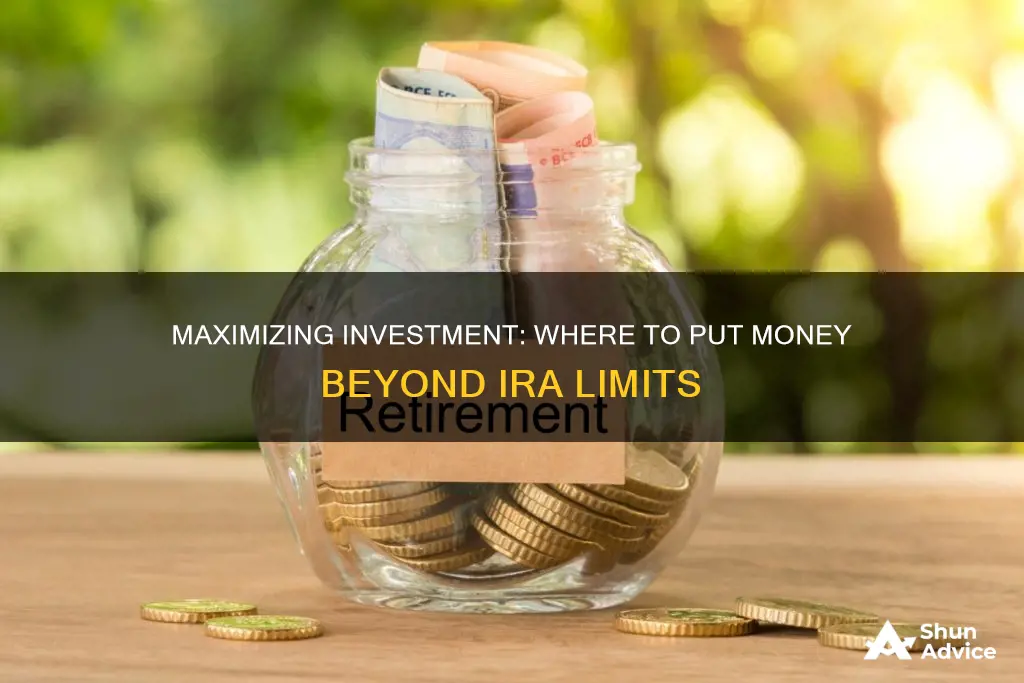
If you've reached the contribution limit on your IRA, there are still plenty of other good places to put your money. While it's hard to beat the tax advantages of an IRA, there are other options for investors to consider, including 401(k)s, Health Savings Accounts (HSAs), brokerage accounts, real estate, and annuities.
A 401(k) is a workplace retirement plan, and many employers will match your contributions up to a certain percentage. If you're self-employed, you can contribute to a Simplified Employee Pension (SEP) IRA or a Savings Incentive Match Plan for Employees (SIMPLE) IRA.
HSAs are designed for healthcare costs, but they can also be a valuable source of income in retirement. Withdrawals are tax-free if used for medical expenses, but you can also withdraw funds for other reasons in retirement, though you'll pay ordinary income tax on these distributions.
A brokerage account offers more flexibility than a retirement account, as there are no income or funding limits, and you can use the assets for any purpose at any time. However, brokerage accounts are funded with after-tax dollars, so there is no tax deduction for your contributions, and you'll pay tax on any dividends, interest, or capital gains distributions.
Another option is to invest in real estate, either through a mutual fund, ETF, or REIT, or by buying property outright.
Finally, annuities are insurance products that provide tax-deferred growth and a guaranteed income stream in retirement. However, they often come with high fees, so it's important to weigh the pros and cons carefully.
| Characteristics | Values |
|---|---|
| Type of Account | Traditional IRA, Roth IRA, Brokerage Account, Health Savings Account (HSA), Tax-Deferred Annuities, Real Estate Investments |
| Tax Benefits | Traditional IRA: upfront tax break; HSA: tax-deductible contributions; Brokerage Account: no tax break |
| Contribution Limits | Traditional/Roth IRA: $7,000 ($8,000 for over 50s); HSA: $4,150 ($8,300 for families) |
| Withdrawal Flexibility | Brokerage Account: no restrictions; Traditional IRA: taxed as ordinary income; Roth IRA: tax-free after 59 1/2 |
| Income Limits | Traditional IRA: no limit; Roth IRA: phase-out range for single filers between $122,000-$137,000; married couples: $193,000-$203,000 |
| Investment Options | Brokerage Account: stocks, bonds, mutual funds, ETFs; Real Estate Investments: REITs, property |
What You'll Learn

Traditional IRA
A traditional IRA is a retirement savings account that offers tax advantages. While there is no income limit for contributions, your ability to deduct these contributions on your taxes is subject to income limits, especially if you or your spouse are covered by a retirement plan at work.
For 2024, the IRA contribution limit is $7,000 for those under 50. Those 50 and older can contribute an extra $1,000 for a total of $8,000. The contribution limit doesn't apply to transfers from other retirement accounts, such as those used to create a rollover IRA. The deadline for IRA contributions for any given tax year is typically April 15 of the following calendar year.
Contributions to a traditional IRA may be tax-deductible in the year they're made, which could help lower your taxable income. Investments in the account, including any earnings, grow tax-deferred until you make withdrawals, which are taxed as ordinary income. There is no minimum required amount for opening an IRA, and no rules about how much money you must deposit.
If you're a non-working spouse, you can have what's called a spousal IRA as long as your spouse earns enough to cover the contribution. That means if you both want to contribute the maximum to an IRA, and you're both under 50, your spouse will need to earn at least $14,000 (to cover the $7,000 annual maximum for each of you in 2024).
The ability to deduct traditional IRA contributions on your taxes is a significant benefit, dependent on your income and whether you're covered by a workplace retirement plan. In 2024, these deductible contributions will see phase-out ranges adjust to ensure more taxpayers can reduce their taxable income through retirement savings.
Below is a table of the income phase-out ranges for traditional IRA deductions for 2024. These ranges determine how much of your IRA contribution can be deducted from your taxable income.
| | 2024 MAGI Deduction Range | 2023 MAGI Deduction Range |
|---|---|---|
| Single, Participants of a workplace retirement plan | Up to $77,000 (Full Deduction), $77,000 - $87,000 (Partial Deduction) Above $87,000 (No Deduction) | Up to $73,000 (Full Deduction), $73,000 - $83,000 (Partial Deduction) Above $83,000 (No Deduction) |
| Married Filing Jointly, Participant of a workplace retirement plan | Up to $123,000 (Full Deduction), $123,000 - $143,000 (Partial Deduction) Above $143,000 (No Deduction) | Up to $116,000 (Full Deduction), $116,000 - $136,000 (Partial Deduction) Above $136,000 (No Deduction) |
| Married Filing Jointly, Spouse is a participant | Up to $230,000 (Full Deduction), $230,000 - $240,000 (Partial Deduction) Above $240,000 (No Deduction) | Up to $218,000 (Full Deduction), $218,000 - $228,000 (Partial Deduction) Above $228,000 (No Deduction) |
| Married Filing Separately, Participant of a workplace retirement plan | Up to $10,000 (Partial Deduction), Above $10,000 (No Deduction) | Up to $10,000 (Partial Deduction), Above $10,000 (No Deduction) |
Tips Mutual Funds: When to Invest for Maximum Returns
You may want to see also

Roth IRA
A Roth IRA is a great way to save for retirement, offering tax-free growth and withdrawals. While there are income limits that may prevent you from opening and contributing to a Roth IRA, there are still ways to benefit from this type of account. Here's everything you need to know about investing in a Roth IRA beyond IRA limits:
Eligibility and Contribution Limits
To be eligible for a Roth IRA, you must have earned income, such as wages, commissions, tips, bonuses, or taxable fringe benefits. The contribution limit for 2024 is $7,000 ($8,000 if you're over 50), and you can't contribute more than your earned income for the year. Additionally, there are income limits that may reduce or eliminate your contribution ability at higher incomes. For 2024, if you're single, your modified adjusted gross income (MAGI) must be under $146,000 to contribute the full amount, with a reduction between $146,000 and $161,000, and no contribution allowed above $161,000. For married couples filing jointly, the limits are $230,000 and $240,000, respectively.
Spousal Roth IRA
If you're married and filing jointly, and only one spouse has earned income, you can still contribute to a spousal Roth IRA. The contributing spouse can fund both their own and their spouse's Roth IRA, as long as the combined contributions don't exceed their earned income. This allows couples with disparate incomes to maximize their retirement savings.
Backdoor Roth IRA
If your income exceeds the Roth IRA limits, you can use a strategy called a backdoor Roth IRA. This involves first contributing to a traditional IRA, and then converting the account to a Roth IRA. This way, you can still benefit from tax-free growth and withdrawals, even if your income is too high for the standard Roth IRA limits.
Benefits of a Roth IRA
There are several advantages to investing in a Roth IRA:
- Tax-free growth: Your contributions are made with after-tax dollars, so the money inside your account grows tax-free.
- Tax-free withdrawals in retirement: You won't have to pay taxes when you take out money during retirement.
- No required minimum distributions (RMDs): There is no mandatory age to start withdrawals, unlike traditional IRAs.
- No age restrictions on contributions: You can continue contributing past retirement age as long as your income is within the limits.
- Beneficiary benefits: You can choose beneficiaries to inherit your Roth IRA, and they can also access the money tax-free.
Other Considerations
While a Roth IRA offers many benefits, there are a few things to keep in mind:
- Income limitations: The income limits may prevent higher earners from contributing the maximum amount or contributing at all.
- Early withdrawal penalties: There are restrictions and penalties for withdrawing earnings before the age of 59½, unless you meet certain exceptions.
- Tax implications: While withdrawals of contributions are tax-free at any time, withdrawals of earnings may be subject to taxes and penalties depending on your age and the five-year rule.
Debt Funds: Where Does Your Money Go?
You may want to see also

Taxable brokerage account
A taxable brokerage account is a popular choice for investors who have maxed out their 401(k) or 403(b) due to its flexibility. There are no income limits or annual funding limitations, and the assets in the account can be used for any purpose at any time.
A brokerage account can be opened at a financial institution of your choosing, and you can fund the account through a lump sum or schedule recurring automatic contributions from your bank. There are no limits on how much you can save annually, and you can pick your investments, although you are limited to the options available at the institution. When you need to withdraw funds, you select which positions to sell and pay any tax due on your investment gains.
As the name suggests, a taxable account is funded with after-tax dollars, so there is no tax deduction for your contributions. You will be taxed annually for dividends, interest, or capital gains distributions, even if you did not sell an investment and reinvested the proceeds. When you liquidate a portion of your account, you will incur a capital gain (or loss) depending on your purchase price and cost basis. If you've held the investment for a year or more, any gain will be taxed at more favourable long-term capital gains rates.
A brokerage account is a good option for those who want to retire early, as you can access the funds without penalty before the typical retirement age of 59 1/2. It also provides tax diversification in retirement. If you only have assets in tax-deferred vehicles like a 401(k), you may have fewer tax planning options each year. With a brokerage account, you can blend withdrawals from both types of accounts or tap tax-deferred assets in years when you're in a lower marginal tax bracket.
Another benefit of a brokerage account is that there are no required minimum distributions (RMDs). There are also no rules on how early you can access the funds, and no regulations on when you must begin tapping the account. This is important as retirees who don't need the income can avoid unnecessary tax consequences, fees, and disruption to their portfolio by staying invested.
Additionally, a taxable brokerage account can be a tax-efficient way to leave a legacy. If your spouse or heirs inherit your account, the assets can pass on a "stepped-up" cost basis, which steps up their inherited cost basis in the asset to the value on the date of your death. This means they can sell the assets without incurring a capital gains tax.
While a taxable brokerage account offers flexibility, growth potential, and no contribution limits, there are some disadvantages. One of the main drawbacks is the tax burden, which can significantly reduce your overall returns. Additionally, taxable brokerage accounts do not offer the same tax benefits as tax-advantaged accounts, and there is a risk of loss if your investments decline in value.
Income Funds: The Right Time to Invest
You may want to see also

Health Savings Accounts (HSAs)
HSAs offer a triple tax advantage: the money you contribute is tax-free, your contributions grow tax-free, and as long as you use the money to pay for qualified medical expenses, you won't pay taxes on withdrawals. Additionally, once you turn 65, you can withdraw money from your HSA for any purpose; you will pay taxes on these withdrawals, just like with a traditional IRA.
For 2024, individuals can contribute up to $4,150 to their HSAs, while those with family coverage can contribute up to $8,300. If you are 55 or older, you can contribute an additional $1,000. It's important to note that you cannot contribute to an HSA once you enroll in Medicare.
HSAs can be a powerful tool for saving for retirement, especially when paired with an HDHP. Not only do they help you save for future medical expenses, but they also provide tax advantages that can reduce your annual tax bill. Additionally, unlike Flexible Spending Accounts (FSAs), HSAs do not have a "use it or lose it" policy, and the funds do not expire. This means that your entire balance rolls over every year, even if you change health plans, retire, or leave your employer.
When considering an HSA, it's important to understand the eligibility requirements and restrictions. To be eligible, you must have an HSA-eligible plan, typically an HDHP with a minimum annual deductible and maximum out-of-pocket expenses. Additionally, you cannot have healthcare coverage beyond qualified health plans, including Medicare enrollment, and you cannot be claimed as a dependent on someone else's tax returns or be receiving certain Veterans Affairs benefits.
Vision Fund's WeWork Investment: A Bold, Early Move
You may want to see also

Real estate investments
Real estate can be a great investment option for those who have already maxed out their IRA contributions for the year. However, it is important to note that there are certain rules and restrictions when it comes to using your IRA to invest in real estate.
Firstly, you will need a self-directed IRA to hold real estate as an investment. This is because traditional IRAs are limited to certain asset classes, such as stocks, bonds, and mutual funds. With a self-directed IRA, you can invest in alternative assets such as residential and commercial properties, mortgage notes, land, and more. You can choose from a self-directed Roth IRA, Traditional IRA, SEP IRA, SIMPLE IRA, or Solo 401(k).
One of the most important rules to keep in mind is that the IRA owns the property, not the individual. This means that you and your family cannot use the property for personal purposes. It must be strictly for investment purposes, such as generating rental income or potential appreciation in value. Additionally, certain family members and disqualified persons, such as your spouse, children, parents, and service providers of your IRA, cannot benefit from the property.
Another thing to consider is that purchasing real estate within an IRA usually requires paying in cash. This can be a large expense that affects your rate of return. Furthermore, since your IRA doesn't pay taxes, you won't be able to take advantage of deductions like mortgage interest payments or property tax deductions. All expenses related to the property, such as maintenance, property taxes, and repairs, must be paid with IRA funds.
When it comes to selling the property, remember that real estate is a notoriously illiquid investment. It may take a long time to divest, and you could lose money in the process.
Overall, investing in real estate with your IRA can provide diversification and long-term appreciation potential for your retirement portfolio. However, it is important to carefully consider the rules and restrictions to avoid any tax penalties.
Class C Mutual Funds: When to Invest and Why
You may want to see also







